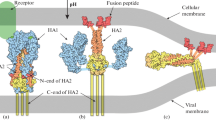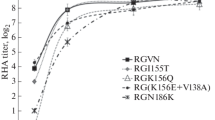Abstract
The complete amino acid sequences of the hemagglutinin (HA) glycoprotein of three equine-2 influenza viruses from tropical Africa are presented in comparison with that of a well characterized European equine-2 virus (Suffolk/89) and a consensus sequence from the database. The sequences of the tropical African viruses were deduced from the complete nucleotide sequences of their HA genes reported earlier. Mutational changes in the nucleotide sequences resulted in amino acid changes in the HA which led to the introduction of a new asparagine-linked (N-linked) glycosylation site in two viruses. This new glycosylation site enhanced the infectivity of these viruses as investigated by plaque assay, virus titration in embryonated chicken eggs and tunicamycin treatment. The role of N-linked glycosylation of influenza virus HA glycoprotein in virus infectivity, antigenicity and immunogenicity is discussed in the light of the results of our previous and present investigations.
Similar content being viewed by others
References
Adeyefa C.A.O., McCauley J.W.: Outbreak of equine influenza in polo horses in Ibadan, Nigeria: virus isolation, clinical manifestation and diagnosis.Vet. Res. 134, 683–684 (1994).
Adeyefa C.A.O. McCauley J.W.: Antigenic variation among Nigerian strains of equine H3 HA influenza viruses.J. Sci. Res., in press (1996).
Adeyefa C.A.O., Quayle K., McCauley J.W.: A rapid method for the analysis of influenza virus genes: application to the reassortment of equine influenza virus genes.Virus Res. 32, 392–398 (1994).
Adeyefa C.A.O., McCauley J.W., Daneji A.I., Kalejaiye O.A., Bakare A., Ashimolowo A.:In-vitro andin-vivo studies on the immunogenicity of influenza A viruses in equines.Trop. Vet. 13, 153–168 (1995).
Adeyefa C.A.O., Hamblin C., Cullinane A., McCauley J.W.: Nationwide serological survey of equine influenza in Nigeria.Revue Elev Med. Vet. Pays. Trop. 49, 2–5 (1996a).
Adeyefa C.A.O., James M.L., McCauley J.W.: Genetic and antigenic analysis of equine influenza viruses from tropical Africa in 1991.Epidem. Infect. 117, 367–374 (1996b).
Bosch F.X., Garten W., Klenk H.D., Rott R.: Proteolytic cleavage of influenza virus hæmagglutinin: primary structure of the connecting peptide between HA1 and HA2 determines proteolytic cleavability and pathogenicity of avian influenza viruses.Virology 118, 725–735 (1981).
Caton A.J., Brownlee G.G., Yewdell J.W., Gerhard W.: The antigenic structure of influenza virus A/PR/8/34 hæmagglutinin (H1 subtype).Cell 3, 417–427 (1982).
Clague M., Schoh C., Blumenthal R.: Delay time for influenza virus hæmagglutinin-induced membrane fusion depends on hæmagglutinin surface density.J. Virol. 65, 2402–2407 (1991).
Gibson C.A., Daniels R.S., Oxford J.S., McCauley J.W.: Sequence analysis of the equine H7 influenza virus hæmagglutinin gene.Virus Res. 22, 93–106 (1992).
Hu A., Cattaneo R., Schwartz S., Norrby E.: Role of N-linked oligosaccharide chains in the processing and antigenicity of measles virus hæmagglutinin protein.J. Gen. Virol. 74, 1043–1052 (1994).
Knipe D.M.: Virus-host-cell interactions, inVirology, 2nd ed. (B.N. Fields, D.M. Knipe, (Eds). Raven Press, New York 1990.
Skehel J.J., Stevend D.J., Daniels R.S., Douglas A.R., Knossow M., Wiley D.C.: A carbohydrate side chain of hæmagglutinin of Hong Kong influenza viruses inhibits recognition by a monoclonal antibody.Proc. Nat. Acad. Sci. USA 81, 1779–1783 (1984).
Wiley D.C., Skehel J.J.: The structure and function of the hæmagglutinin membrane glycoprotein of influenza virus.Ann. Rev. Biochem. 56, 365–394 (1987).
Wood J., Mumford J.: Epidemiology of equine influenza.Vet. Res. 130, 126 (1992).
Author information
Authors and Affiliations
Rights and permissions
About this article
Cite this article
Adeyefa, C.A.O., McCauley, J.W. & Tomori, O. Mutational changes in the hemagglutinin of equine H3 influenza viruses result in the introduction of a glycosylation site which enhances the infectivity of the viruses. Folia Microbiol 42, 390–394 (1997). https://doi.org/10.1007/BF02816955
Received:
Issue Date:
DOI: https://doi.org/10.1007/BF02816955




